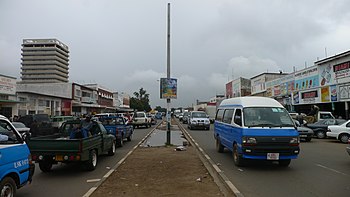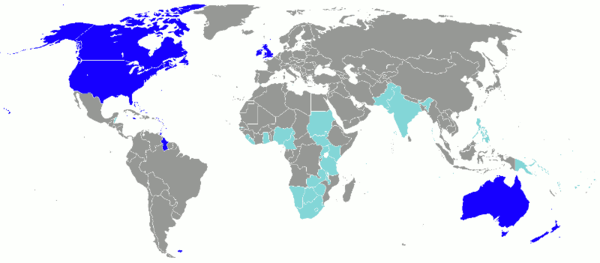Languages of Zambia

Zambia has several major indigenous languages,[1] all of them members of the Bantu family. English is the official language and the major language of business and education.[2][3]
Indigenous Zambian languages[]
Zambia is widely claimed to have over 72 languages and dialects. Most of these might be better regarded as dialects. Some of them have a long history in Zambia, while others, such as Silozi, arose as a result of 18th- and 19th-century migrations. All of Zambia's vernacular languages are members of the Bantu family and are closely related to one another.[3]
Although there are several languages spoken in Zambia, seven of them were officially recognized as regional languages, and they still have this official status.[4][3] Together these represent the major languages of each province: Bemba (Northern Province, Luapula, Muchinga and the Copperbelt), Nyanja (Lusaka), Lozi (Western Province), Tonga and Lozi (Southern Province), and Kaonde, Luvale and Lunda (Northwestern Province). These seven languages are used, together with English, in early primary schooling and in some government publications. A common orthography was approved by the Ministry of Education in 1977.[5][6]
According to the 2000 census, Zambia's most widely spoken languages are Bemba (spoken by 35% of the population as either a first or second language), Nyanja (37%), Tonga (25%) and Lozi (18%).[7]
In some languages, particularly Bemba and Nyanja, Zambians distinguish between a "deep" form of the language, associated with older and more traditional speakers in rural areas, and urban forms (sometimes called "town language" or Chitauni, such as Town Bemba and ) that incorporate a large number of borrowings from English and other innovations.[8]
An urban variety of Nyanja is the lingua franca of the capital Lusaka and is widely spoken as a second language throughout Zambia. Bemba, the country's largest indigenous language, also serves as a lingua franca in some areas.[9]
Significance of Zambian languages[]
Local Zambian languages play an important role in different sectors of society.[10] For instance, in the education sector, local languages allow pupils to express themselves freely.
Zambian English[]
English, the former colonial language, serves as a common language among educated Zambians. At independence in 1964, English was declared the national language. English is the first language of only 2% of Zambians but is the most commonly used second language.[11]
The English spoken in Zambia has some distinctive features, such as the omission of certain object pronouns that would be obligatory in Western English ("Did you reach?"), the simplification of some phrasal verbs ("throw" instead of "throw away"), subtle differences in the usage of auxiliary verbs such as "should", simplification of vowel sounds (some Zambians may regard "taste" and "test" as homophones), and the incorporation of particles derived from Zambia's indigenous languages (such as chi "big/bad" and ka "little"). Zambian English also incorporates South African words such as braai for "barbecue".[citation needed]
Percentage distribution of major language groups[]
| Language Group | 1990 | 2000 | 2010 |
|---|---|---|---|
| Bemba | 39.9 | 38.5 | 31.0 |
| Nyanja | 20.1 | 20.6 | 25.3 |
| Tonga | 14.8 | 13.9 | 17.5 |
| Kaonde | 8.8 | 9.7 | 6.6 |
| Barotse | 7.5 | 6.9 | 9.3 |
| Tumbuka | 3.7 | 3.2 | 3.3 |
| Mambwe | 3.4 | 3.2 | 3.2 |
| English | 1.1 | 1.7 | 1.7 |
| Other | 0.8 | 4.3 | 0.3 |
Source: 2010 Census[12]
List of languages[]
- Ambo
- Aushi
- Bemba
- Bisa
- Chewa
- Chikunda
- Cishinga
- Chokwe
- English
- Gova
- Ila
- namwanga
- Iwa
- Kabende
- Kaonde
- Kosa
- Kundai
- Kwandi
- Kwandu
- Kwangwa
- Lala
- Lamba
- Lenje
- Leya
- Lima
- Liyuwa
- Lozi
- Luanoď
- Luchazi
- Lumbu
- Lunda
- Lundwe
- Lungu
- Luunda
- Luvale
- Makoma
- Mambwe
- Mashasha
- Mashi
- Mbowe
- Mbukushu
- Mbumi
- Mbunda
- Mbwela
- Mukulu
- Mulonga
- Namwanga
- Ndembu
- Ng'umbo
- Ngo'ni
- Nkoya
- Nsenga
- Nyengo
- Nyiha
- Sala
- Seba
- Senga
- Shanjo
- Shila
- Simaa
- Soli
- Subiya
- Swaka
- Tabwa
- Tambo
- Toka
- Tonga
- Totela
- Tumbuka
- Twa
- Unga
- Wandya
- Yombe
References[]
- ^ Safaris, Discover Africa. "Languages in Zambia | Everything to know | Discover Africa Safaris". www.discoverafrica.com. Retrieved 2020-05-25.
- ^ Safaris, Discover Africa. "Languages in Zambia | Everything to know | Discover Africa Safaris". www.discoverafrica.com. Retrieved 2020-05-25.
- ^ Jump up to: a b c "Zambian Languages". Zambian Translators International. Retrieved 2020-05-25.
- ^ Chanda and Mkandawire (2013)
- ^ Chimuka (1977)
- ^ Kashoki (1981).
- ^ catalog.ihsn.org https://catalog.ihsn.org/index.php/catalog/4121. Retrieved 2020-05-25. Missing or empty
|title=(help) - ^ Spitulnik, Debra (1998). "The Language of the City: Town Bemba as Urban Hybridity". Journal of Linguistic Anthropology. 8 (1): 30–59. doi:10.1525/jlin.1998.8.1.30. ISSN 1055-1360. JSTOR 43102583.
- ^ Spitulnik, Debra (1998). "The Language of the City: Town Bemba as Urban Hybridity". Journal of Linguistic Anthropology. 8 (1): 30–59. doi:10.1525/jlin.1998.8.1.30. ISSN 1055-1360. JSTOR 43102583.
- ^ Mkandawire(2017a)
- ^ "(PDF) One Zambia, One Nation, Many Languages". ResearchGate. Retrieved 2021-05-24.
- ^ Central Statistical Office, Government of Zambia. "2010 Census Population Summaries" (PDF). Retrieved 6 March 2018.
Bibliography[]
- Chimuka, S. S. (1977). Zambian languages: orthography approved by the Ministry of Education. Lusaka : National Educational Company of Zambia (NECZAM).
- Kashoki, Mubanga E. and Ohannessian, Sirarpa. (1978) Language in Zambia. London: International African Institute.
- Kashoki, Mubanga E. (1981). Harmonization of African languages: standardization of orthography in Zambia in In African Languages: Proceedings of the Meeting of Experts on the Transcription and Harmonization of African Languages, Niamey (Niger), 17–21 July 1978, (pp. 164–75). Paris: UNESCO.
- Kashoki, Mubanga E. (1990) The Factor of Language in Zambia. Lusaka: Kenneth Kaunda Foundation.
- Marten, Lutz; Kula, Nancy C. (2008) "One Zambia, One Nation, Many Languages" in Simpson, A. ed., 2008, Language and National Identity in Africa, Oxford: OUP, 291–313.
- Chanda, Vincent M. and Mkandawire, Sitwe Benson. (2013). 'Speak Zambian Languages'. Lusaka: UNZAPRESS
- Mkandawire, S. B. (2017). "Familiar Language Based Instruction versus Unfamiliar Language for the Teaching of Reading and Writing Skills: A Focus on Zambian Languages and English at two Primary Schools in Lusaka". Zambian Journal of Language Studies, 1(1), 53–82. ISSN 2415-668X
- Mkandawire, Sitwe Benson (2017b). "Terminological Dilemma on Familiar language based instruction and English language: A reflection on Language of Initial Literacy Instruction in Zambia" Journal of Lexicography and Terminology, 1(1), 45–58. ISSN 2517-9306
- Tambulukani, Geoffrey Kazembe (2015). "First Language Teaching of Initial Reading: Blessing or Curse for the Zambian Children under Primary Reading Programme?" Ph.D. thesis, University of Zambia.
- Tordoff, William (ed.) (1974) Politics in Zambia. Manchester: Manchester University Press.
- Republic of Zambia. Constitution of Zambia 1991 (as amended by Act no. 18 of 1996).
See also[]
External links[]
- Languages of Zambia
